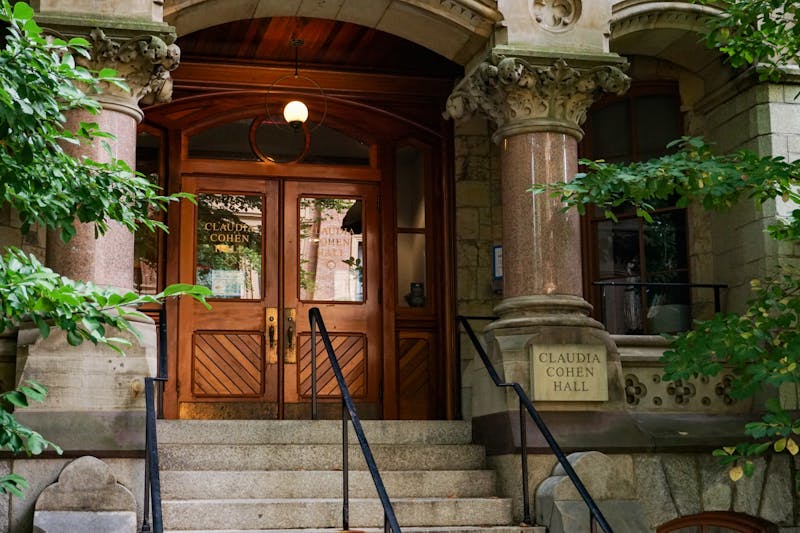
What constitutes safe biking depends on who you ask.
The reality is that the strained road relationship between motorists, bicyclists and pedestrians stems from inattention to the laws of the road on all sides.
Graduate student Nikos Svoronos was involved in an accident with a car while riding his bike. A driver was making a turn at the intersection of 38th and Spruce streets, and Svoronos was hit while trying to avoid the driver.
While Svoronos said that West Philadelphia is generally a safe place for cyclists, he called safety on the road “a common sense thing.”
Assistant to the Chair of the Department of Genetics in the Perelman School Sadie Robinson — who co-founded the Penn Bike Commuters group with Health and Societies professor David Barnes — spoke to motorists’ lack of knowledge about the laws, “There’s definitely a lot of aggression from drivers,” she said.
Vagelos professor David Christianson had a close encounter with a cyclist at the intersection of 34th and Walnut streets. He said that a cyclist made an illegal left turn through a red light and nearly sideswiped Christianson while he crossed the street.
“I would be scared to be a cyclist in the city partly because of the cars and partly because of the other cyclists,” Christianson said.
Christianson said that when he filed a concern with the Division of Public Safety about the incident, police told him that they issue citations to cyclists violating traffic laws, with fines ranging from $55.50 to $137.50.
“It’s a lawful order that’s meant to protect the community,” Vice President of Public Safety Maureen Rush said of the laws in place for cyclists, adding that DPS enforces traffic laws for everybody on the road. “When there are people parked in the bike lane, we will ticket them and we will chase them.”
It’s easy to turn bike safety into a blame game, but DPS said that safety is a shared responsibility.
“In an accident, the car is going to be the one to blame and that’s not always necessarily true,” Wistar Institute research assistant Patricia Reyes — who cycles between campus and Fairmount — said.
“A lot of cyclists have to defend themselves against rules that they believe target them unfairly,” Robinson said.
As the laws stands, bicycles are considered vehicles and held to the same traffic laws as motor vehicles — apart from being banned from highways.
In Philadelphia, it is illegal to ride a bike on the sidewalk if you're over 12-years-old — an infraction carrying a fine of $57 in a business district, according to DPS.
On Penn’s campus, bikes are not allowed on Locust Walk and other campus walkways during the hours of 8:30 a.m. to 5:30 p.m. Monday through Friday.
Robinson said that the restrictions placed on campus biking are not productive for encouraging ridership, however. She suggested either including a bike lane on the campus walks or just allowing bikes and creating clear signage to instruct pedestrians and cyclists.
DPS expressed their commitment to issuing warnings first and actively educating everyone in the community about bicycle safety practices. Cyclists driving recklessly and repeat offenders may face more aggressive penal actions like traffic tickets.
“We give a ton of warnings out, we try to educate people,” Rush said.
Pennsylvania passed a law in April 2013 mandating that a four-foot buffer be given to cyclists when vehicles pass them on roads. Additionally, by law, bikes are allowed to use the entire road lane even if a bike lane exists, and cars must yield to both pedestrians and bikes traveling straight when attempting to turn right.
Robinson noted a marked improvement in road behavior during her six years biking in the city, crediting the growing number of cyclists and awareness in Philadelphia.
DPS, in collaboration with groups like the Undergraduate Assembly, PennCycle, MERT and the Bicycle Coalition of Greater Philadelphia, among others, hosts the Share the Road campaign that kicks off annually in the fall.
The UA has a committee dedicated to bicycle safety that has worked with Student Health Services on their research involving concussions from bike accidents. They have also advocated to extend the bike lanes on campus.
“[The UA] is serving as a facilitator for efficient communication between these organizations,” rising College junior Aidan McConnell — who worked extensively on bicycle safety initiatives on the UA this past semester.
University City is a part of Philadelphia’s bike share program, which is expected to begin in 2015, according to the city’s website. With the expected increased population of cyclists, DPS has increased their efforts to educate the public about safety issues in tandem with the growing number of accidents.
“We could have a thousand police officers out there and it wouldn’t be enough,” Rush said, saying DPS would rather encourage people to take their personal safety seriously than issuing traffic tickets.
A previous version of this article stated that it is illegal to ride one's bike on the sidewalk if one is under 12 years old. The law actually states that those over 12 years of age cannot ride a bike on the sidewalk. The DP regrets the error.
The Daily Pennsylvanian is an independent, student-run newspaper. Please consider making a donation to support the coverage that shapes the University. Your generosity ensures a future of strong journalism at Penn.
DonatePlease note All comments are eligible for publication in The Daily Pennsylvanian.







